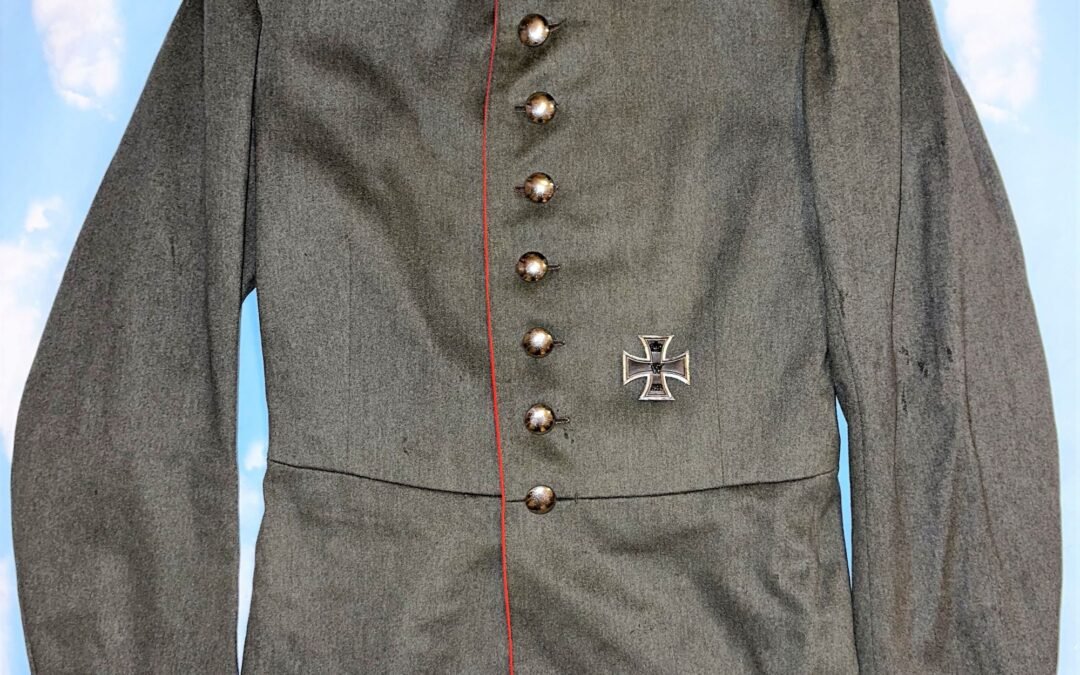
by brandefined | May 31, 2023
Step into the captivating history of Prinz Heinrich of Bavaria with this remarkable Friedensrock Infanterie-Leib-Regiment Major Tunic. Prinz Heinrich (1884-1916) possessed a fascinating story, having been tutored by a man named Himmler in his youth, who later sought permission to name his son after the young prince. Thus, Heinrich Himmler, of WW II “fame,” came to be….

by Alore Arrington | Nov 22, 2016
Prinz Heinrich of Prussia (1862-1929) was Kaiser Wilhelm II’s younger brother. They were both sons of Kaiser Friedrich III and grandsons of Kaiser Wilhelm I. Heinrich established a career in the Kaiserliche Marine. He became a cadet in 1877 and advanced through the ranks, commanding several German Navy ships. He commanded the royal yacht S. M. Y. Hohenzollern from 1889 through 1890. Next, he commanded several large ships, then was promoted to Konteradmiral in 1899, commanding the East Asia Squadron. In 1909 he was promoted to the rank of Großadmiral. The only six men to achieve the rank were:
Kaiser Wilhelm II
King Gustav of Sweden
Hans von Koester
Prinz Heinrich
Alfred von Tirpitz
Henning von Holtzendorff
Wilhelm II and Gustav of Sweden were symbolic appointments, while the other four men held true administrative/command positions. In the case of Prinz Heinrich, he was Commander in Chief of the Baltic Fleet beginning in 1914, commanding that fleet until the end of the war with Russia in 1917. Nevertheless, he was successful and his modest fleet gave the Russians a good run for their money. When the war with Russia ended, Heinrich retired from the naval service. In his old age his interests turned to aviation (he was one of Germany’s first pilots at the turn of the century), motorsports, and sailing. He died in 1929 from cancer of the throat, as had his father.
Today we offer a dinner plate from Prinz Heinrich’s personal service. The plate measures 9 1/4″ in diameter. Around the plate’s edge is a light-blue and gold trim. In the center we see Prince Heinrich’s crowned cypher. Please examine our accompanying photos carefully to see the wear on his cypher’s gold arms. It clearly comes from years of cleaning, washing, and stacking the plates in pantries. This accounts for the wear visible today. The plate’s bottom is hallmarked for KPM of Berlin. The firm first began producing tableware for members of the House of Hohenzollern during König Friedrich der Große’s reign. This included the manufacture of pieces for the princes and princesses of the house, not just the ruling head. Aside from the noted wear to the cypher, the plate is in very good condition.
by Alore Arrington | Nov 10, 2016
Princess Irene of Hesse and by Rhine (Irene Luise Maria Anna) (1866 – 1953) was the third child and third daughter of Princess Alice of the United Kingdom and Ludwig IV, Grand Duke of Hesse and by Rhine. Her maternal grandparents were Queen Victoria of the United Kingdom and Prince Albert. She was married to Prinz Heinrich of Prussia, Kaiser Wilhelm II’s younger brother.
by Alore Arrington | Nov 10, 2016
This postcard shows Prinz Heinrich of Prussia, his wife, and two sons.
by Alore Arrington | Nov 10, 2016
This is a postcard, NPG Nr 5349, that shows Prinz Heinrich of Prussia (the younger brother of Kaiser Wilhelm II) in the uniform of a Großadmiral, shaking hands with Generalfeldmarschall Paul von Hindenburg.
by Alore Arrington | Nov 10, 2016
This pose is from a charcoal sketch of Prinz Heinrich of Prussia (1862-1929). Heinrich was Kaiser Wilhelm II’s younger brother. He was a Großadmiral in the Kaiserliche Marine. At the postcard’s bottom are a reproduced 1916 message and signature from Großadmiral Prinz Heinrich. He is wearing a PLM at his throat.
by Alore Arrington | Nov 10, 2016
This postcard shows Prinz Heinrich of Prussia in a charcoal or ink sketch. Prinz Heinrich was Kaiser Wilhelm II’s younger brother. Heinrich was one of the six großadmiral’s created by the Kaiserliche Marine. He commanded the German Navy in the Baltic against the Russians during WW I. This was mailed as a Feldpostkarte in 1916.

by Alore Arrington | Nov 10, 2016
This is a very smart-looking color postcard of Prinz Heinrich of Preußen, Kaiser Wilhelm II’s younger brother. He is wearing a großadmiral’s gala uniform.

by Alore Arrington | Nov 10, 2016
This is an intriguing color postcard that features Kaiser Wilhelm II’s younger brother Heinrich, Großadmiral and Prince of Prussia (1862-1929). Heinrich was one of the Kaiserliche Marine’s six großadmirals during its existence. Here, Heinrich appears resplendent in his gala uniform, complete with all his bestowed orders and decorations. His portrait is small and contained within a laurel leaf wreath. The portrait is inserted within a painting by Professor Willy Stöwer, one of Germany’s most famous naval painters at the time. The painting features the fleet’s flagship, the S.M.S. Deutschland, at Kiel. Please note: below Prinz Heinrich’s portrait is his flag denoting he is an admiral, AND a flag proclaiming him a House of Hohenzollern prince. The latter flag was flown on any vessel on which a prince traveled. [We currently are offering such a flag on our FLAG MERCHANDISE PAGE, ROYALTY MERCHANDISE PAGE, and NAVY MERCHANDISE PAGE. Click on any of these three page titles to see it]. Finally, the postcard displays the reproduction signatures of Prinz Heinrich and two other personages. It was not mailed.
by Alore Arrington | Nov 10, 2016
This pose is from a charcoal sketch of Prinz Heinrich of Prussia (1862-1929). Heinrich was Kaiser Wilhelm II’s younger brother. He was a Großadmiral in the Kaiserliche Marine.
by Alore Arrington | Nov 10, 2016
This postcard shows Prince Heinrich of Prussia, his wife, and two sons. It is a pre war photograph. Heinrich was very popular with the German people as he was Kaiser Wilhelm II’s younger brother. The postcard was not mailed.
by Alore Arrington | Nov 10, 2016
This postcard depicts Prinz Heinrich of Prussia. He is featured within a highly decorative frame embossed on the postcard. The background of the card’s obverse is light-blue. An extensive message is written on this background, as was the custom of the period. The reverse reveals it was mailed in 1900. Only the address and a canceled postage stamp from Kiel are visible.
by Alore Arrington | Nov 10, 2016
This postcard shows Prinz Heinrich of Prussia and his family. Heinrich was Kaiser Wilhelm II’s younger brother, and one of Germany’s most-popular royals. He has been photographed wearing civilian attire in a garden. He is seated with his wife and their two young sons. One served in the Army and the other in the Navy during WW I. The photograph was taken during WW I. The postcard was not mailed.
by Alore Arrington | Nov 8, 2016
This postcard shows Prinz Heinrich of Prussia driving an automobile. Heinrich was Kaiser Wilhelm II’s younger brother, and one of Germany’s most-popular royals. He is seen here at an event in Lübeck. Heinrich was a supporter of aviation and automobiles in Germany well before WW I. He continued to have some involvement with automobiles after the war. He was also an inventor. The postcard mailed in 1907.

by Alore Arrington | Dec 23, 2018
PRUSSIA – DAMASCUS COURT DEGEN – ATTRIBUTED TO PRINZ HEINRICH
Honestly, this magnificent sword is the most important edged weapon I have ever shared with you. We have offered Royals’ swords in the past, but NEVER at such a high level. It is actually a Court Degen, one that was used at high court occasions, not for the more typical military parades. Its owner was none other than our old friend, Prinz Heinrich of Prussia (1862-1929), Kaiser Wilhelm II’s younger brother. Heinrich was, first and foremost, a Navy Man. He was one of only six men to be elevated to the position of Großadmiral in 1909. He was also the only man to receive the rank of Großadmiral with Patent. [Von Tirpitz was a Großadmiral WITHOUT patent, meaning he was not allowed to use a Großadmiral’s crossed batons on his shoulder boards and epaulettes, but four pips instead. The latter were equivalent to a Generaloberst in the rank of Generalfeldmarschall in the Army, which was more often a ceremonial rank that given to Royals who had NO true command responsibilities, but instead served as Regimental Chefs].
During WW I, Prinz Heinrich commanded the German Baltic fleet against the Russians. In addition to Heinrich’s naval responsibilities, the Prinz was the Regimental Chef of four regiments, as well as the 1. Garde Regiment zu Fuß’s Generaloberst in the Rank of Generalfeldmarschall.
Two of Heinrich’s swords from the five different commands mentioned above were very plain-looking swords. [I have had the privilege of acquiring and passing them along to new homes]. The keys to their royal attribution were the royal cyphers exhibited on their pommels. Their blades were NOT engraved, and not what one usually expected from a royal. [From all that I have read, Heinrich was a modest and thoughtful man. It appears he was more careful than his brother Wilhelm II when it came to spending the Reich’s money. To call Wilhelm II a lavish spender is a gross understatement]!
As a ceremonial Court Degen, THIS sword is far more elaborate than the others I have had. To begin, it sports a “D” guard grip, with an intricately designed pommel and pommel top. The pommel’s cap features Prinz Heinrich’s royal cypher, as did his other swords. The grip is covered with black sharkskin and single-wire-wrapped in gilt. The grip also displays the Garde Star that is seen on Garde-Regiments’ headdresses. The Degen also presents a clamshell guard that folds up in order to preserve the sword’s already slender, compact nature. It is made of very fine, smooth, supple leather rather than metal (naval swords also feature leather scabbards), which is in fantastic condition with NO major problems. A brass hanger is attached to the scabbard’s reverse so that it may be attached to a belt. The scabbard’s tip does display some scuffing, as well as a brass plate.
When removed from its scabbard, the blade is revealed to be forged of luxurious “Damascus” steel. [According to Wikipedia, “Damascus steel was the forged steel comprising the blades of swords smithed in the Near East from ingots of wootz (crucible) steel imported from India and Sri Lanka. These swords are characterized by distinctive patterns of banding and mottling reminiscent of flowing water. Such blades were reputed to be tough, resistant to shattering, and capable of being honed to a sharp, resilient edge]. These elaborate sword blades are very highly prized. In addition to the Damascus pattern that extends over the blade’s length, at its top is a fantastic gold engraving that centers around a widespread eagle sans Hohenzollern Crown. The gold extends up to the point where the blade begins.
The sword measures 38″ end to end. The blade measures 33″ inches. The handle measures 5.5″ x 3″
This Degen can serve as any collection’s centerpiece. As far as I am concerned, it is Der Rittmeister’s top item of the year.
consignment item.
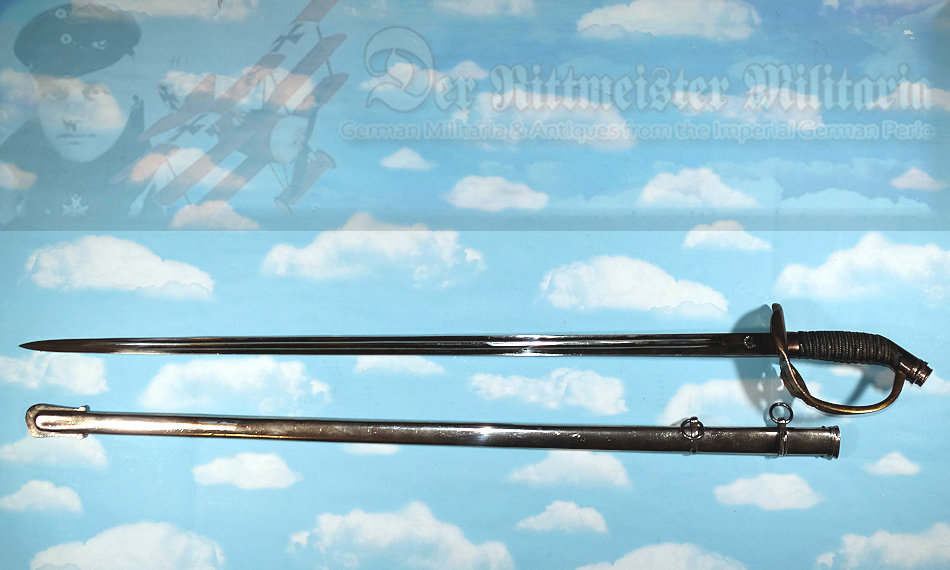
by Alore Arrington | Sep 6, 2018
SWORD – PRUSSIA – INFANTERIE OFFIZIER’S M-1889 DEGEN – ATTRIBUTED TO PRINZ HEINRICH.
Our offering today is a sword that does NOT display any regimental information. However, we have clear evidence that attributes it to Prinz Heinrich of Prussia (1862-1929), Kaiser Wilhelm II’s younger brother, which we will present below. As you may remember, Heinrich was Kaiser Friedrich III’s second son, and one of Imperial Germany’s more popular royals. Primarily a Navy man, he rose in rank to eventually become one of only six men to achieve the rank of Großadmiral. [Here’s an interesting historical tidbit: Prinz Heinrich commanded the royal yacht S.M.Y. Hohenzollern in 1888]. He eventually rose to command all German Navy units based out of Kiel. During WW I, he operated chiefly in the Baltic. His primary opponent was Russia, which had second-rate equipment at best. [Heinrich’s naval vessels were not much better].
While Prinz Heinrich was a Großadmiral in the Kaiserliche Marine, he also served as a Generaloberst in the rank of Generalfeldmarschall in the Imperial German Army. Like all Prussian House of Hohenzollern princes, he had been mustered into the 1. Garde-Regiment zu Fuß at a very young age. He eventually became the Regimental Chef of regiments from Saxony, Bavaria, and Hesse-Darmstadt, as well as the Füsilier-Regiment Prinz Heinrich von Preußen (1. Brandenburgisches) Nr 35. Prinz Heinrich received the latter appointment in 1896. [This regiment was raised in 1815, garrisoned at Brandenburg a.H., and assigned to the Prussian III. Armeekorps].
In the case of all of the regiments for which Heinrich served as Regimental Chef (or Colonel-in-Command), he held the rank of Generaloberst in the rank of Generalfeldmarschall. The latter rank was an honorary title intended for use by royals who did NOT have direct field commands. Each of these regiments actually was commanded on a daily basis by a military career Oberst or Oberstleutnant. Regimental Chefs appeared with “their” regiments for parades and special events, wearing uniforms and headdresses that were identical to those worn by the regiment’s rank and file members. Some of the regiments that Prinz Heinrich represented were Artillerie Regiments, in which case he donned a kugelhelm. When he was accompanying his Infanterie Regiments, he sported a pickelhaube.
Although this sword lacks the regimental markings that would assist in its identification, it does give us clues. Commonly referred to as an “IOD 89,” the sword is officially entitled as a “Preußisches Infanterie Offizier Degen M-1889.” It measures 40” in length from the hilt’s top to the bottom of its scabbard. When drawn from the scabbard, it measures 38” in length, while the blade is 32.” The bright nickle scabbard has two rings with which to mount it onto a sword belt. [Two-ring scabbards were used prior to 1906. After 1906, they were reduced to sporting a single ring].The scabbard features a couple of minor dings and some scratching, which is quite good for a more than 100-year-old sword.
The sword’s hilt is made of finely fire-gilded brass that displays a magnificent finish in lovely condition. The ebony-colored, single-brass-wire-wrapped grip (I am reasonably certain) is made of tight, straight sharkskin. The grip also displays Kaiser Wilhelm II’s brass royal cypher. The oval-shaped pommel brandishes the sword’s most-exciting feature and a major clue, Prinz Heinrich of Prussia’s royal cypher, a crowned “H.” When removed from its scabbard, the blade reveals a plain, unadorned finish in exceptional condition. NO special engraving is present, just handsome, double blood-gutters. Its white felt buffer is discolored with age, yet still protects the blade from rubbing against the hilt. Near the blade’s top we see its manufacturer’s name, “Weyersberg & Stamm – Solingen.” This small firm did a lot of contract work for Austria’s and Bavaria’s Militaries, as well as special orders for Prussian officers, another clue.
Now it is time to pull all the research and other details together. Years ago, I was privileged to acquire a complete 1. Garde-Regiment zu Fuß group for Prinz Heinrich. This group included his mitre, his tunic with epaulettes, and a sword, which was nearly identical to the sword we are offering today. Its blade was also quite plain and sported Prinz Heinrich’s crowned cypher on its pommel. That first sword and the rest of its group are now in the hands of a very advanced collector. The end result is that Heinrich was associated with only one other Prussian regiment, his “own” Füsilier-Regiment Prinz Heinrich von Preußen (1. Brandenburgisches) Nr 35! All of the other regiments for which he was the Regimental Chef were NOT Prussian, meaning IT is the most likely regiment from which it came.
Royalty items are always sought-after. It is seldom that we can offer you an edged weapon from a German royal. It is rarer yet to offer an edged weapon from Prinz Heinrich! He was arguably the third best-known member of the House of Hohenzollern after Wilhelm II and his son Kronprinz Wilhelm.
This has been one of the most interesting and challenging descriptions that I have written in a long time. I hope that you have enjoyed the description as much as I have in writing it. I further hope to find a good home for this fine sword! This is a consignment item.
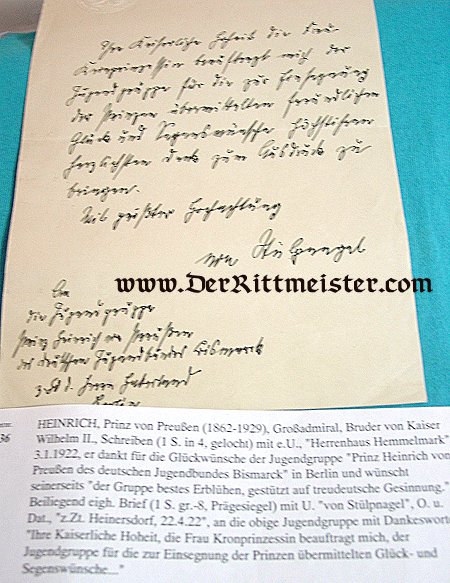
by Alore Arrington | Nov 23, 2016
This is an original letter written by Prinz Heinrich of Prussia (1862-1929)……
by Alore Arrington | Nov 15, 2016
This postcard shows a very young Prinz Ernst Heinrich (1896-1971) from the Kingdom of Saxony. He was König Friedrich August III’s third and youngest son. He served in an assorted number of military positions during WW I. The photo shows him as a very young leutnant of approximately 10-12 years of age. The postcard was not mailed.
by Alore Arrington | Nov 10, 2016
This postcard shows Prinz Heinrich of Prussia (1862-1929) and his wife, Princess Irene (1866-1953) of Hesse by Rhine. He is dressed in a Navy admiral’s uniform. He was one of only six großadmirals ever created in the Kaiserliche Marine. The postcard was produced to benefit a children’s hospital, a special charity of the Prince. The postcard was never mailed.
by Alore Arrington | Nov 10, 2016
This postcard shows Kaiser Wilhelm II’s younger brother, Prinz Heinrich. Heinrich was one of the Kaiserliche Marine’s six großadmirals. During WW I, he commanded the German fleet in the Baltic against the Russians. In this postcard he is wearing the Royal Motor Club’s uniform. [Interestingly, the organization had its own dagger, very similar to a naval dagger]. The postcard was mailed from Hannover in 1912.
by Alore Arrington | Nov 10, 2016
This postcard shows Kaiser Wilhelm II’s younger brother, Prinz Heinrich. Heinrich was one of the Kaiserliche Marine’s six großadmirals. During WW I, he commanded the German fleet in the Baltic against the Russians. Here, he is shown from the chest up in the Kaiserliche Marine’s gala admiral’s uniform. Below his image is a message from Prinz Heinrich, along with a reproduction signature. It is dated 1914. The reverse reveals the postcard was produced for the German Red Cross’s benefit. We further see that it was mailed as a Feldpostkarte in 1915.
by Alore Arrington | Nov 10, 2016
This postcard shows Kaiser Wilhelm II’s younger brother, Prinz Heinrich. Heinrich was one of the Kaiserliche Marine’s six großadmirals. During WW I, he commanded the German fleet in the Baltic against the Russians. Here, he is shown from the waist up in the Kaiserliche Marine’s gala admiral’s uniform. The postcard was not mailed.
by Alore Arrington | Nov 8, 2016
This postcard shows the Kaiser’s younger brother, Prinz Heinrich, in profile. He is wearing a Grand Admiral’s uniform, complete with the Orden Pour le Mérite at his neck. The postcard was not mailed.
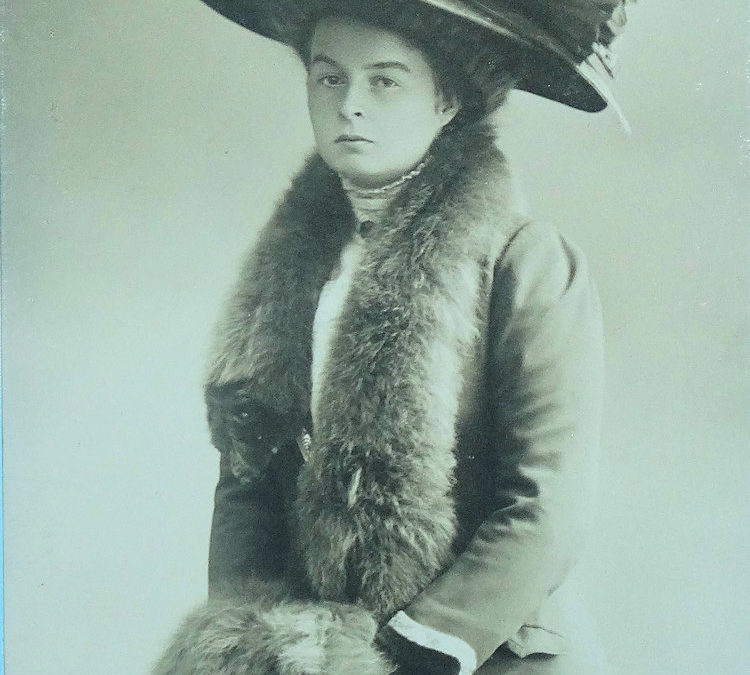
by Alore Arrington | Jun 5, 2020
This postcard depicts Prinzessin Victoria Margarete of Prussia (1890-1923). Her father was Prinz Friedrich Leopold (1865-1931), who was Prinz Friedrich Karl’s (1828-1885) son. Through her mother, Victoria was a niece of Kaiserin Augusta Victoria, Wilhelm II’s wife. She married Prinz Heinrich XXXIII Reuss of Köstritz (1879-1942) in May 1913. They divorced on July 14, 1922. She died a year later at age 33. The princess certainly loved BIG picture hats! In this photo, she is wearing a sash and feather concoction with a fur-collared coat and matching fur muff.
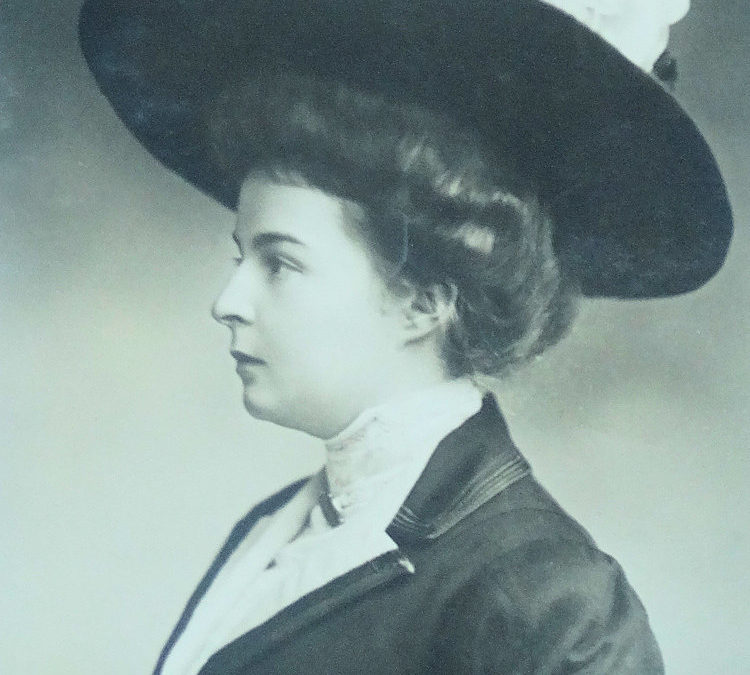
by Alore Arrington | Jun 5, 2020
This postcard depicts Prinzessin Victoria Margarete of Prussia (1890-1923). Her father was Prinz Friedrich Leopold (1865-1931), who was Prinz Friedrich Karl’s (1828-1885) son…
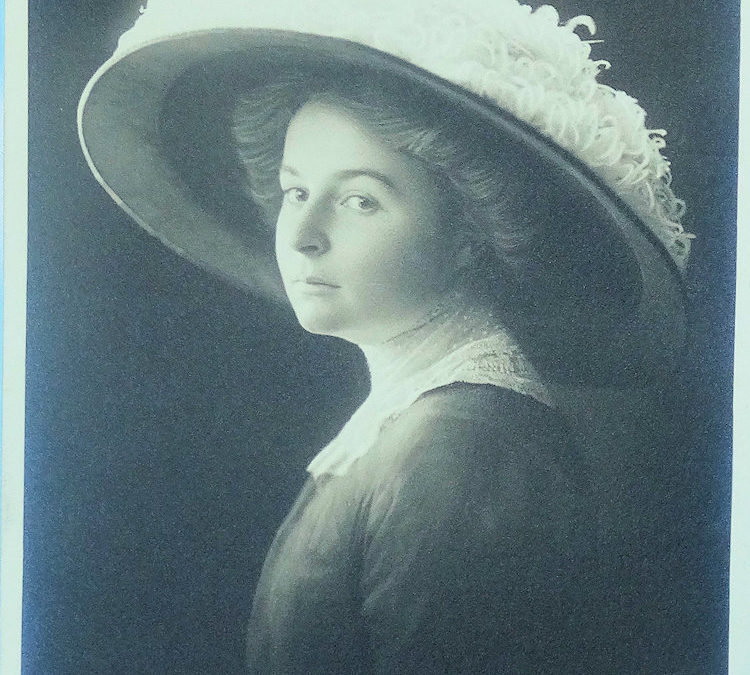
by Alore Arrington | Jun 5, 2020
This postcard depicts Prinzessin Victoria Margarete of Prussia (1890-1923). Her father was Prinz Friedrich Leopold (1865-1931), who was Prinz Friedrich Karl’s (1828-1885) son….
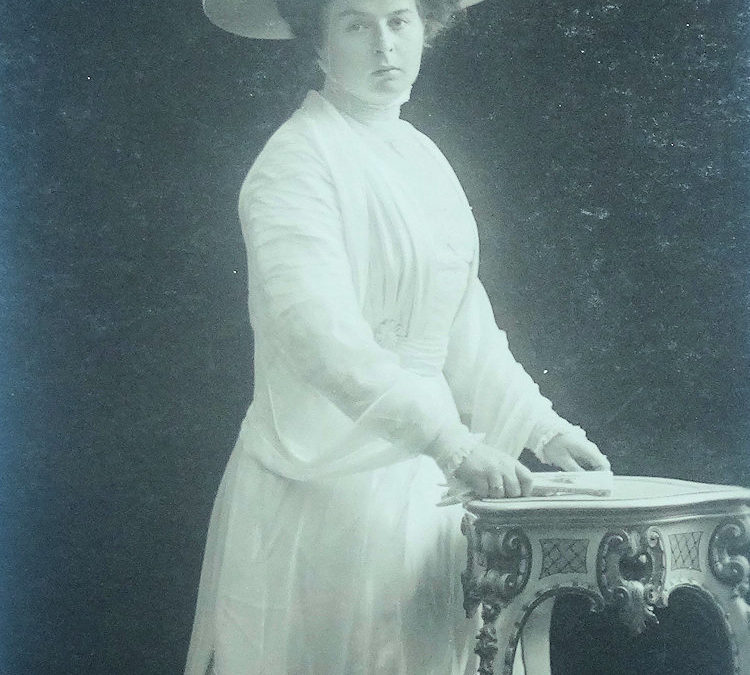
by Alore Arrington | Jun 5, 2020
This postcard depicts Prinzessin Victoria Margarete of Prussia (1890-1923). Her father was Prinz Friedrich Leopold (1865-1931), who was Prinz Friedrich Karl’s (1828-1885) son….

by Alore Arrington | Jan 23, 2018
This is a simply delicious 1. Garde Regiment zu Fuß officer’s spiked helmet. The regiment was the most elite among Prussia’s and Germany’s Infanterie Regiments. It was garrisoned in Potsdam with its Kavallerie Regiment counterpart, the Regiment der Garde du Corps. The regiment was loaded with denizens of Imperial Germany’s highest royal and noble families. Every Hohenzollern Prinz was invested in it, including all of Kaiser Wilhelm II’s sons, just as the Kaiser himself had been as a young man. The Kaiser also served as its Regimental Chef……
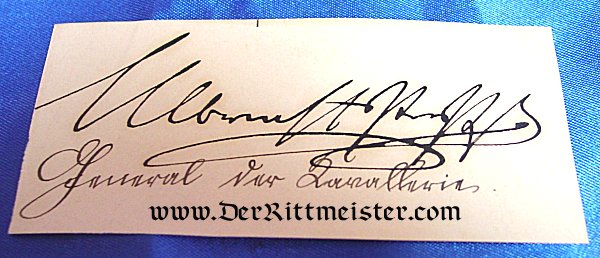
by Alore Arrington | Nov 28, 2016
This is a clipped autograph (a clipped signature from a document or letter) of Prinz Albrecht von Preußen (1809-1872)……
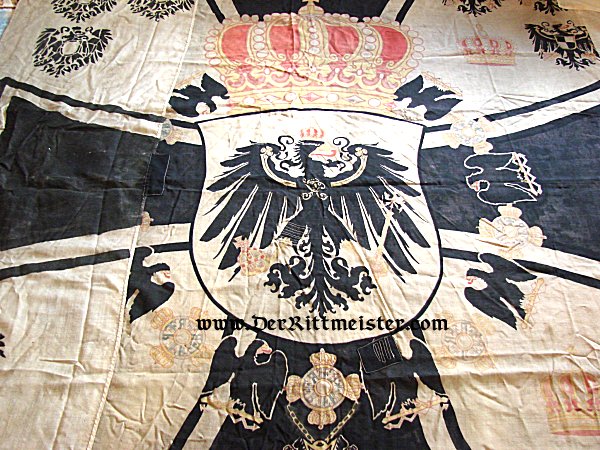
by Alore Arrington | Aug 17, 2016
This is an incredible standard/banner that was used on Kaiserliche Marine vessels. The banner proclaimed the presence of a Prinz of the House of Hohenzollern on board. Three Hohenzollern Princes are the most likely to have had this particular flag flown for them. The senior of the three was Großadmiral Prinz Heinrich (1862-1929). He was Kaiser Wilhelm II’s (1859-1941) younger brother. The second was Kaiser Wilhelm II’s son, Prinz Adalbert (1884-1948). The final prince was Prinz Heinrich’s son, Prinz Waldemar (1889-1945). That said, if ANY Hohenzollern Prinz were visiting a ship (even if he served in the Army), this flag would have correctly flown to honor and recognize him. The standard measures a whopping 6’ 11″(83″) x 6’ 6″(78.”) The banner’s center sports a large Hohenzollern Eagle within a shield. Below that is an important symbol of Prussian royalty, the Black Eagle Collar. [An excellent representative of the Collar resides at Haus Doorn, Kaiser Wilhelm II’s residence-in-exile, in the Netherlands. The last example I saw on the market, which had belonged to the King of Bulgaria, sold with its presentation case for more than $100,000!] Above it all sits a red and gold Hohenzollern Crown. The entire arrangement is superimposed on a large Iron Cross measuring 5′ 11″ (71″) x 6′ 6″(78.”) Two more smaller Hohenzollern Crowns appear to the right of the shield. The upper left and lower right corners feature smaller Hohenzollern Eagles. Two repair patches show in the upper and lower right corners. No tearing or rips are apparent, although substantial fading has occurred from exposure to the elements. The standard’s right side displays a lanyard and other fittings by which it can be attached to a ship’s halyard. Normally, members of the royal house only visited battleships and battle cruisers, so typically one would not see this banner on a small vessel. The flag is somewhat similar to the Kaiser’s Standard, but some differences exist. Its overall condition is average, or a bit better. This is not an unused, or mint flag. It has seen service. It exhibits the expected wear a cotton item such as this experiences when exposed to salt air, salt water, smoke, etc. It is a great item for any royal or naval collection.

by brandefined | Feb 17, 2020
German naval operations were based in two areas of Germany: the North Sea’s Wilhelmshaven and the Baltic Sea’s Kiel. [During WW I Kaiser Wilhelm II’s brother, Prinz Heinrich of Prussia, was a Großadmiral (the only Großadmiral to have tactical command at the front) based at Kiel. He was responsible for operations in the Baltic against the Russians. Kiel was always a secondary front, since Wilhelmshaven hosted Germany’s biggest, newest, and best ships as they faced the English fleet. This was particularly true in 1916 when the two fleets clashed at the Battle of Jutland (Skagerrak)]….

by brandefined | Jun 26, 2019
GERMANY – PRESENTATION SWORD – LOTHAR VON RICHTHOFEN – DAMASCUS LIONSHEAD – NO SCABBARD. Over the years, we have been privileged to offer you some very interesting edged weapons. [Most recently, this included a spectacular Court Degen that once belonged to Prinz Heinrich of Prussia, Kaiser Wilhelm II’s younger brother]. Today’s sword is equally intriguing, and presents a unique historical background. It is a presentation sword for Lothar Freiherr von Richthofen (1894-1922), which was given to him by a family friend. Although Manfred is the more famous of the two brothers, Lothar was an equally-accomplished flyer who achieved spectacular results in a relatively-short time period at the Front.
Imperial German aristocrats often practiced a custom wherein a male child’s birth required that the father (or a close family friend) present his son with a sword. A family friend of Albrecht von Richthofen, Lothar’s father, presented this Kavallerie sword to the boy. Serving in Prussia’s Kavallerie was something of a tradition within the von Richthofen family. Albrecht had served in Kürassier-Regiment Nr 1, and eventually achieved the rank of Major. While rescuing one of his troopers from a river, the Major damaged one of his ears, which led to his being medically retired from active service. Later on his sons continued the tradition, with Manfred serving in an Ulanen-Regiment, while Lothar belonged to a Dragoner-Regiment.
[PLEASE allow me to fill in some background information about the way this wonderful sword came to its current owner. This gentleman’s father served in the U.S. Army during the 1960’s. He was based in West Berlin, where he was in charge of all the Western sector’s military clubs. From time to time, the father crossed into East Germany on U.S. Army business, or to scout out militaria artifacts to add to his collection (a man after my own heart)! He discovered this sword during a museum visit, and was able to acquire it. The sword remained with the family for many years, then was passed on to the son when his father died. That son has now entrusted Der Rittmeister Militaria to find it a new home].
You will notice that this sword does NOT have a scabbard. It does, however, boast a “Damascus” blade. Damascus blades are among the finest swords that one can find, and are VERY desirable to edged weapon collectors. It is a type of steel known for its amazing sword characteristics. Damascus blades display an unusual pattern in the steel due to different elements present during the smelting process. [If you will indulge me with this comparison, a Damascus blade could be considered the Porsche of edged weapons]! This handsome, massive, Lionshead presentation sword measures 38 ½” from the brass Lionshead atop the pommel to its elaborately-engraved blade’s tip. The blade’s width (it measures 1 ½” at its widest point) helps to confirm its status as a presentation piece.
The Lionshead and the rest of the brass-fitting on the sword handle’s back are adorned with elaborate scroll-work running down from the lion’s mane, while the brass guard displays a pattern of finely sculpted oak leaves and acorns coming out from the lion’s jaws. The Lionshead’s eyes are made of faceted black stone or glass, and are NOT original. [The current owner remembers seeing the sword for the first time when he was a boy, and noticing that its eye sockets were empty. His father had a jeweler insert the black stones later]. The sword’s brass, quillon finial (cross guard’s end-piece) sports a smaller, less elaborate Lionshead. The sword’s sharkskin grip (which displays some worn areas) is triple wire-wrapped (a copper strand, a twisted, silver-toned, metal strand, and a second copper strand). Decorative brass rain guards adorn both sides of the cross guard. One rain guard features crossed cavalry swords above two leafy, berry-bedecked branches that are tied together at the base. The other rain guard boasts the von Richthofen Coat-of-Arms, with a Freiherr’s (Baron’s) Crown perched atop the knight’s helmet. The underside of the cross guard features the words “Geschütztes Muster” (Protected Pattern), which means the design essentially was copyrighted.
The blade itself features elaborate, somewhat faded, gilt engravings upon the elegant Damascus steel. Gilt scroll-work decorates the upper part of the sword’s spine above the false edge. The sword’s ricasso (unsharpened length of blade just above the guard) displays the words “Gust. (av) Günther Metz.” This firm was involved in producing “Drillings” (a combination gun with three barrels that was used by sportsmen all over Europe). [Gustav Günther Metz evidently worked with the steel and weapons company Krupp, probably specializing in producing decorative plates for the shotguns and specially decorated sword blades].
Just below the rain guard that features the cavalry swords the blade is decorated with a panel displaying two scrolls inside a border of oak leaves and acorns. The first scroll displays the name v.(von) Wendt u. (und) Niemann i/l.” The second scroll reads “Frhr. v. Richthofen” (Freiherr von Richthofen, Lothar’s father), “Metz,” and “1894″ (the year of Lothar’s birth). The panel’s decoration is finished with an illustration of a Kavallerie Offizier’s sword, Pickelhaube, and Küraß sitting atop a military drum.
The blade’s reverse contains five different panels filled with gilt illustrations. They start just below the rain guard depicting the von Richthofen family crest. Most of them are typical of the images found on military-themed sword blades. The most interesting panel features ANOTHER very detailed gilt image of the von Richthofen Coat-of-Arms. [PLEASE NOTE the illustration at left]. The Coat-of-Arms features two crowned knights’ helmets above a Freiherr’s Crown, with a stork perched atop the right-hand helmet. In turn, the Freiherr’s Crown sits on top of a heraldic shield held between two rampant lions. The shield features items related to the family’s history. The seated figure on the right depicts a judge, which relates to the family name’s original meaning (“Richter” means judge, while “Hof” means court).
In conclusion, this is a historically-important sword associated with a famous German family that produced two of WW I’s best fighter pilots. [Manfred’s story is related on other parts of our website]. Lothar shot down forty enemy planes during the war, and commanded Jasta 11 on many occasions. He was a PLM winner and, unlike his brother, survived the war. Tragically, he died in a 1922 Hamburg air crash. [PLEASE NOTE: the accompanying photos feature one of Lothar’s Sanke Cards in which he is holding a Lionshead sword that we feel is similar to the sword on offer. We do see some small differences between them, and thus do NOT think they are one and the same].
This is a consignment item.

by brandefined | Oct 9, 2018
GROßADMIRAL’S SHIP’S FLAG WITH STORAGE BAG.
This is a consignment item. The Kaiserliche Marine (and its improvement) was a project close to the hearts of Kaiser Wilhelm II and the Imperial German Navy’s Secretary of State, Alfred von Tirpitz. As Queen Victoria of England’s eldest grandson (Wilhelm’s mother was Victoria’s eldest daughter), Wilhelm spent a good part of his childhood visiting England and hobnobbing with his many royal British relations. His regard for his grandmother’s naval forces eventually became a passion for Germany to equal and SURPASS his British cousin’s Royal Navy. Under Wilhelm II and von Tirpitz a massive build-up took place that saw the Kaiserliche Marine’s scope greatly advance. No matter how many ships Germany built, however, England continually raised the ante by producing more ships with much-improved designs. Germany had spent much of the 18th and 19th Centuries struggling to unite its many small states and kingdoms, and fending off incursions from the likes of Napoleon, which left it little time to pursue foreign colonial expansion. By the time Germany finally consolidated into an empire, only a few small areas were available for colonization. Also, Chancellor von Bismarck had disdained colonial expansion, and had seen little need for a larger navy, which was one of the many reasons that von Bismarck found himself retired shortly after Wilhelm II ascended the Imperial throne!
Once he came into power, Wilhelm II wasted no time in expanding his beloved navy. Until 1901, the Kaiserliche Marine’s highest rank had been that of an Admiral, which was equivalent to a General der Infanterie. [The German Navy’s only three “Flag Ranks” were Konteradmiral, Vizeadmiral, and Admiral]. This meant the Navy had no rank equivalent to the Army’s Generaloberst or Generalfeldmarschall. Wilhelm changed the situation in 1901 by establishing the rank of Großadmiral and, unsurprisingly, naming himself the rank’s first recipient. From that time until the German Empire’s demise, a total of six men achieved the rank, (listed below).
1901 – Kaiser Wilhelm II (1859–1941)
1901 – King Oskar II of Sweden (1829–1907)
28 June 1905 – Hans von Koester (1844–1928)
4 September 1909 – HRH Prinz Heinrich of Prussia (1862–1929)
27 January 1911 – Alfred von Tirpitz (1849–1930)*
*[Promoted on an Honorary Basis w/o Patent, and thus not authorized to wear a Großadmiral’s crossed batons.
Instead, his shoulder boards and/or epaulettes displayed four pips].
31 May 1918 – Henning von Holtzendorff (1853–1919)
Our offering today is an ultra rare Großadmiral’s flag. [PLEASE NOTE: in the Kaiserliche Marine, an Admiral of any rank was considered a “Flag” officer. Thus he was permitted to fly “his” flag from any ship that he was stationed aboard or visiting. This was especially true when a Großadmiral visited a ship]. The flag is amazingly beautiful to look at. My imagination immediately whisks me to when it flew from a battleship hosting one of the Großadmirale (a rather infrequent occasion). The massive flag measures 87″ x 89″ (220cm x 225cm) and is made with two different types and weights of cotton. The flag’s bulk consists of very gauzy, lightweight cotton, which was necessary for such a large flag. When held up to the light, it appears almost opaque. The areas featuring the German cross sport a far heavier cotton to protect the overall design and promote an inherent sense of strength.
The flag’s center features the pair of crossed batons emblematic of a Großadmiral’s office and rank. [To view similar crossed batons, you can look at those on Kaiser Wilhelm II’s single shoulder board (click here to see) or those on Großadmiral Hans von Koester epaulettes (click here to see) Both are currently for sale]. A Großadmiral’s batons, whether on his shoulder boards/epaulettes or on the actual baton he carried, were totally different from those for a Generalfeldmarschall (and far more beautiful, in my opinion). At any rate, the flag’s batons are very large and beautifully detailed. They give the flag some vivid pops of color, including metallic gold, blue, and red. The metallic paint was applied by hand. The flag’s artwork is amazing. The time and effort that went into creating this breathtaking flag had to have been considerable.
Many different sections of the flag do display stains. I do not know what caused them, but they appear across the flag. The flag shows MINIMAL mothing. NO markings whatsoever are present on the flag’s bunting. Two attachments for the lanyards necessary for when the flag was flown are present. Its storage bag is made from lightweight canvas and measures 11 ½” x 42.” The bag is dingy with age and has several holes and rust stains at its base. The base is held together by a metal clip in its center.
The flag is in surprisingly good condition, considering its age, size and the materials from which it was constructed. The consignor tells us that the auction house from which he purchased the flag stated that it had belonged to Großadmiral von Holtzendorff. No provenance other than this information is available, however. It remains an amazing historical artifact.

by brandefined | Feb 16, 2018
This is a single Großadmiral’s shoulder board that once adorned Kaiser Wilhelm II’s uniform. Only six men achieved this exalted rank in the Imperial German Navy’s history. These men included:
1901 – Kaiser Wilhelm II (1859 – 1941)
1901 – King Oskar II of Sweden (1829 – 1907)
28 June 1905 – Hans von Koester (1844 – 1928)
4 September 1909 – HRH Prinz Heinrich of Prussia (1862 – 1929)
27 January 1911 – Alfred von Tirpitz (1849 – 1930)*
*[Promoted on an Honorary Basis without Patent, and thus NOT
authorized to wear his shoulder boards with the crossed batons
(the other five recipients could do so).]
31 May 1918 – Henning von Holtzendorff (1853–1919)
A Großadmiral’s rank in the Kaiserliche Marine was equivalent to that of a Generalfeldmarschall in the German Army, hence the use of crossed batons. The shoulder board is massive, measuring 2 ¼” x 5 .” It sports two gold bullion braids sandwiching a center silver bullion braid as the primary background. The silver bullion braid sports black chevrons that identify it as a naval shoulder board, since the Navy was part of the Reich (Empire) [not even such a mighty Kingdom as Prussia had possessed a Navy]. A magnificent set of crossed 2 ¼” Großadmiral’s batons is installed on the gold/silver bullion ropes. [Full-sized batons were issued to any man who achieved this rank, with the owner’s name noted on each one. Also please note: although the Großadmiral’s shoulder board batons have the same measurements as those on a Generalfeldmarschall’s shoulder board, the similarity ends there]. The Großadmiral batons’ attention to detail is amazing. If you look closely, you can see Prussian Crowns AND fouled Navy anchors! Instead of being silver, they are painted in THREE colors. Their primary background color is dark copper enamel, although much of it has worn off to reveal the gold beneath. The Hohenzollern Eagles and anchors are painted/enameled gold. Each baton tip is also gold with a small band of white enamel just below it.
The sumptuous detailing just keeps on coming! Kaiser Wilhelm II’s royal cypher is laid over the batons, with a beautiful Prussian Crown directly above it. Both are rendered in subdued brass that blends attractively with the batons. The obverse’s final item is a gilt-toned naval button displaying a crowned, fouled anchor. The reverse features a fine, dark-blue felt underlay, which ALWAYS appears on any Navy officer’s shoulder board. Some very light mothing shows on the fabric. An unusual circular brass backing plate holds the naval button in place.
Although we have offered Kaiser Wilhelm II’s shoulder boards in the past, this may be our rarest example yet!

by Alore Arrington | Nov 22, 2016
This is a very rare bread or dessert plate from his racing sloop, the S. M. Y. Iduna. The Kaiser was an avid sailor. He had a special place in his heart for his Navy AND his personal yachts. Although the Kaiser employed the luxurious S. M. Y. Hohenzollern to travel all over Europe and the Middle East with his family and various guests, the S. M. Y. Iduna was reserved for yacht racing and activities associated with the Kaiserlicher Yacht Club (KYC), in which he served as Commodore. The KYC had its origins in a yacht club originally founded in 1887 for Kiel’s naval officers. It had been known as the Marine-Regatta-Verein, and its original patron was Prinz Heinrich of Prussia, Wilhelm II’s younger brother. Heinrich was a serving officer in the Kaiserliche Marine and a yachting enthusiast. [He later rose to the rank of Großadmiral and commanded the German naval forces based in Kiel against the Russians].
In 1891, the club was opened to civilians as well as naval officers. Industrialist and arms manufacturer Alfred Krupp, along with other well-known Germans, joined the group. The members then asked Kaiser Wilhelm II to become its patron and renamed it the Kaiserlicher Yacht Club. [Naval officers revived the Marine-Regatta-Verein in 1928, and it continued to exist into WW II. It was disbanded by the Allies after the war, then re-founded in 1972 as the Marine-Regatta-Verein im Deutschen Marinebund e.V., and continues to this day].
Today we are offering a fantastic bread or dessert plate that was part of the Kaiser’s personal table service when aboard the S. M. Y. Iduna. [PLEASE NOTE: Wilhelm II’s wife, Kaiserin Augusta Viktoria, had her own tableware for the S. M. Y. Iduna. We are fortunate enough to hold a single example of it. Note also that Johannes von Karpf served as commander of both the S. M. Y. Iduna and the S. M. Y. Hohenzollern. He later rose to the rank of Admiral in the Kaiserliche Marine]. This magnificent plate measures 6 ½” in diameter. It has two different styles of gold trim bands around its edges. Its centerpiece is an Order of the Black Eagle Kette, whose center features the motto “Suum Cuique” (To each according to his own merits). The latter also appeared on the headdresses of Gardekorps Garde units, such as the Infanterie, Kavallerie, Artillerie, and etc.
The Kaiserlicher Yacht Club’s burgee (pennant) appears at the plate’s top. Just below the burgee, the KYC’s initials appear in gold over a blue bandeau displaying the name “Iduna” in gold. The plate’s reverse displays KPM of Berlin’s proper hallmarks. This notable firm, which still exists today, was the House of Hohenzollern’s official purveyor for all its royalty.
The plate comes from what may be the rarest tableware setting that Kaiser Wilhelm II owned. His naval tableware is much rarer than that featured at his various palaces, primarily because the ships’ smaller dining rooms accommodated far fewer guests. Since it was a racing sloop, the S. M. Y. Iduna was the smallest by far of all the Kaiser’s vessels, rendering any surviving examples of its tableware quite rare. The inclusion of the Kaiserlicher Yacht Club’s burgee makes it a very desirable piece. It is a pleasure to share it with you today.
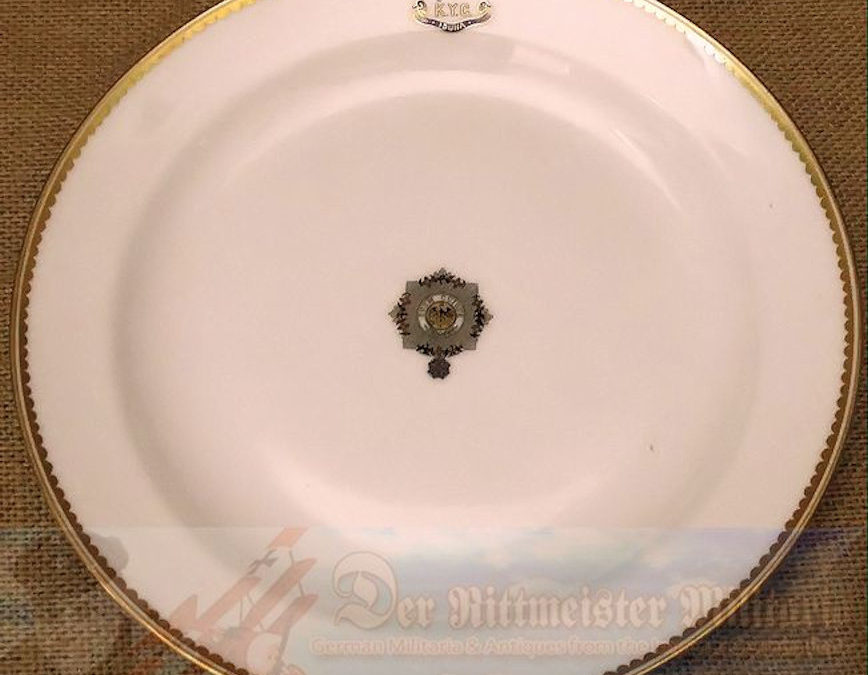
by Alore Arrington | Nov 22, 2016
This is a very rare salad plate from the S. M. Y. Iduna, Kaiser Wilhelm II’s racing sloop. The Kaiser was an avid sailor. He had a special place in his heart for his Navy AND his personal yachts. Although the Kaiser employed the luxurious S. M. Y. Hohenzollern to travel all over Europe and the Middle East with his family and various guests, the S. M. Y. Iduna was reserved for yacht racing and activities associated with the Kaiserlicher Yacht Club (KYC), in which he served as Commodore. The KYC had its origins in a yacht club originally founded in 1887 for Kiel’s naval officers. It had been known as the Marine-Regatta-Verein, and its original patron was Prinz Heinrich of Prussia, Wilhelm II’s younger brother. Heinrich was a serving officer in the Kaiserliche Marine and a yachting enthusiast. [He later rose to the rank of Großadmiral and commanded the German naval forces based in Kiel against the Russians].
In 1891, the club was opened to civilians as well as naval officers. Industrialist and arms manufacturer Alfred Krupp, along with other well-known Germans, joined the group. The members then asked Kaiser Wilhelm II to become its patron and renamed it the Kaiserlicher Yacht Club. [Naval officers revived the Marine-Regatta-Verein in 1928, and it continued to exist into WW II. It was disbanded by the Allies after the war, then re-founded in 1972 as the Marine-Regatta-Verein im Deutschen Marinebund e.V., and continues to this day].
Today we are offering a fantastic salad plate that was part of the Kaiser’s personal table service when aboard the S. M. Y. Iduna. [PLEASE NOTE: Wilhelm II’s wife, Kaiserin Augusta Viktoria, had her own tableware for the S. M. Y. Iduna. We are fortunate enough to hold a single example of it. Note also that Johannes von Karpf served as commander of both the S. M. Y. Iduna and the S. M. Y. Hohenzollern. He later rose to the rank of Admiral in the Kaiserliche Marine]. This magnificent plate measures 8 ½” in diameter. It has two different styles of gold trim bands around its edges. Its centerpiece is an Order of the Black Eagle Kette, whose center features the motto “Suum Cuique” (To each according to his own merits). The latter also appeared on the headdresses of Gardekorps Garde units, such as the Infanterie, Kavallerie, Artillerie, and etc.
The Kaiserlicher Yacht Club’s burgee (pennant) appears at the plate’s top. Just below the burgee, the KYC’s initials appear in gold over a blue bandeau displaying the name “Iduna” in gold. The plate’s reverse displays KPM of Berlin’s proper hallmarks. This notable firm, which still exists today, was the House of Hohenzollern’s official purveyor for all its royalty. We also see “1906,” the year that the plate was manufactured and entered into service aboard the S. M. Y. Iduna.
The plate comes from what may be the rarest tableware setting that Kaiser Wilhelm II owned. His naval tableware is much rarer than that featured at his various palaces, primarily because the ships’ smaller dining rooms accommodated far fewer guests. Since it was a racing sloop, the S. M. Y. Iduna was the smallest by far of all the Kaiser’s vessels, rendering any surviving examples of its tableware quite rare. The inclusion of the Kaiserlicher Yacht Club’s burgee makes it a very desirable piece. It is a pleasure to share it with you today.
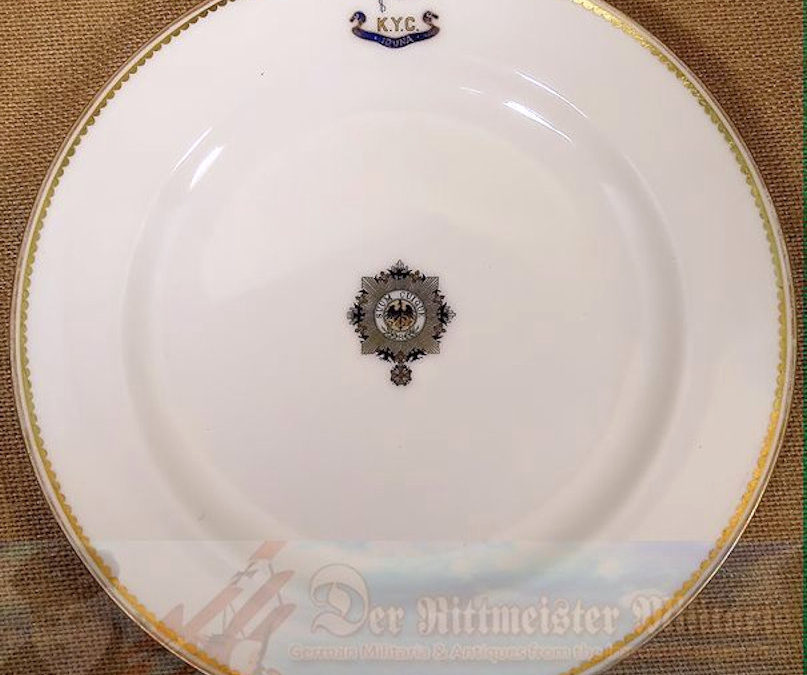
by Alore Arrington | Nov 22, 2016
This is a very rare dinner plate from the S. M. Y. Iduna, Kaiser Wilhelm II’s racing sloop. The Kaiser was an avid sailor. He had a special place in his heart for his Navy AND his personal yachts. Although the Kaiser employed the luxurious S. M. Y. Hohenzollern to travel all over Europe and the Middle East with his family and various guests, the S. M. Y. Iduna was reserved for yacht racing and activities associated with the Kaiserlicher Yacht Club (KYC), in which he served as Commodore. The KYC had its origins in a yacht club originally founded in 1887 for Kiel’s naval officers. It had been known as the Marine-Regatta-Verein, and its original patron was Prinz Heinrich of Prussia, Wilhelm II’s younger brother. Heinrich was a serving officer in the Kaiserliche Marine and a yachting enthusiast. [He later rose to the rank of Großadmiral and commanded the German naval forces based in Kiel against the Russians].
In 1891, the club was opened to civilians as well as naval officers. Industrialist and arms manufacturer Alfred Krupp, along with other well-known Germans, joined the group. The members then asked Kaiser Wilhelm II to become its patron and renamed it the Kaiserlicher Yacht Club. [Naval officers revived the Marine-Regatta-Verein in 1928, and it continued to exist into WW II. It was disbanded by the Allies after the war, then re-founded in 1972 as the Marine-Regatta-Verein im Deutschen Marinebund e.V., and continues to this day].
Today we are offering a fantastic dinner plate that was part of the Kaiser’s personal table service when aboard the S. M. Y. Iduna. [PLEASE NOTE: Wilhelm II’s wife, Kaiserin Augusta Viktoria, had her own tableware for the S. M. Y. Iduna. We are fortunate enough to hold a single example of it. Note also that Johannes von Karpf served as commander of both the S. M. Y. Iduna and the S. M. Y. Hohenzollern. He later rose to the rank of Admiral in the Kaiserliche Marine]. This magnificent plate measures 10″ in diameter. It has two different styles of gold trim bands around its edges. Its centerpiece is an Order of the Black Eagle Kette, whose center features the motto “Suum Cuique” (To each according to his own merits). The latter also appeared on the headdresses of Gardekorps Garde units, such as the Infanterie, Kavallerie, Artillerie, and etc.
The Kaiserlicher Yacht Club’s burgee (pennant) appears at the plate’s top. Just below the burgee, the KYC’s initials appear in gold over a blue bandeau displaying the name “Iduna” in gold. The plate’s reverse displays KPM of Berlin’s proper hallmarks. This notable firm, which still exists today, was the House of Hohenzollern’s official purveyor for all its royalty.
The plate comes from what may be the rarest tableware setting that Kaiser Wilhelm II owned. His naval tableware is much rarer than that featured at his various palaces, primarily because the ships’ smaller dining rooms accommodated far fewer guests. Since it was a racing sloop, the S. M. Y. Iduna was the smallest by far of all the Kaiser’s vessels, rendering any surviving examples of its tableware quite rare. The inclusion of the Kaiserlicher Yacht Club’s burgee makes it a very desirable piece. It is a pleasure to share it with you today.

by Alore Arrington | Nov 22, 2016
Kaiser Wilhelm II was an avid sailor. He had a special place in his heart for his Navy AND his personal yachts. Today we are offering a very rare dinner plate from his racing sloop, the S. M. Y. Iduna. He raced it with the Kaiserlicher Yacht Club (KYC). The latter had its origins in a yacht club originally founded in 1887 for Kiel’s naval officers. It was known as the Marine-Regatta-Verein, and its original patron was Prinz Heinrich of Prussia, Wilhelm II’s younger brother. Heinrich was a serving officer in the Kaiserliche Marine and a yachting enthusiast. [He later rose to the rank of Großadmiral and commanded the German naval forces based in Kiel against the Russians].
In 1891, the club was opened to civilians as well as naval officers. Industrialist and arms manufacturer Alfred Krupp, along with other well-known Germans, joined the group. They asked Kaiser Wilhelm II to become the patron and renamed it the Kaiserlicher Yacht Club. [Naval officers revived the Marine-Regatta-Verein in 1928, and it continued to exist into WW II. It was disbanded by the Allies after the war, then re-founded in 1972 as the Marine-Regatta-Verein im Deutschen Marinebund e.V., and continues to this day].
Today we are offering a fantastic dinner plate that was part of the Kaiser’s personal table service when aboard the S. M. Y. Iduna. [PLEASE NOTE: Wilhelm II’s wife, Kaiserin Augusta Viktoria, had her own tableware for the S. M. Y. Iduna. We are fortunate enough to hold a singe example of it. Also, Johannes von Karpf served as commander of both the S. M. Y. Iduna and the S. M. Y. Hohenzollern. He rose to the rank of Admiral in the Kaiserliche Marine]. This magnificent plate measures 7″ in diameter. It has two different styles of gold trim bands around its edges. Its centerpiece is an Order of the Black Eagle Kette, whose center features the motto “Suum Cuique.” The latter also appeared on the headdresses of Gardekorps Garde units, including Infanterie, Kavallerie, Artillerie, etc. The Kaiserlicher Yacht Club’s burgee (pennant) appears at the plate’s top. Below the burgee the K. Y. C.’s initials appear in gold above a blue bandeau displaying the name “Iduna” in gold.
The plate’s reverse displays KPM of Berlin’s proper hallmarks. This notable firm, which still exists today, was the House of Hohenzollern’s official purveyor for all its royalty. For some reason there is no date from when the plate was manufactured. That said, it is identical in every way to the other S. M. Y. Iduna plates.
The plate comes from what may be the rarest tableware setting that Kaiser Wilhelm II owned. His naval tableware is much rarer than that featured at his various palaces, primarily because the ships’ smaller dining rooms accommodated far fewer guests. Since it was a racing sloop, the S. M. Y. Iduna was by far the smallest of all the Kaiser’s vessels, rendering any surviving examples of its tableware quite rare. The inclusion of the Kaiserlicher Yacht Club’s burgee makes this a very desirable piece. It is a pleasure to be able to share it with you today.
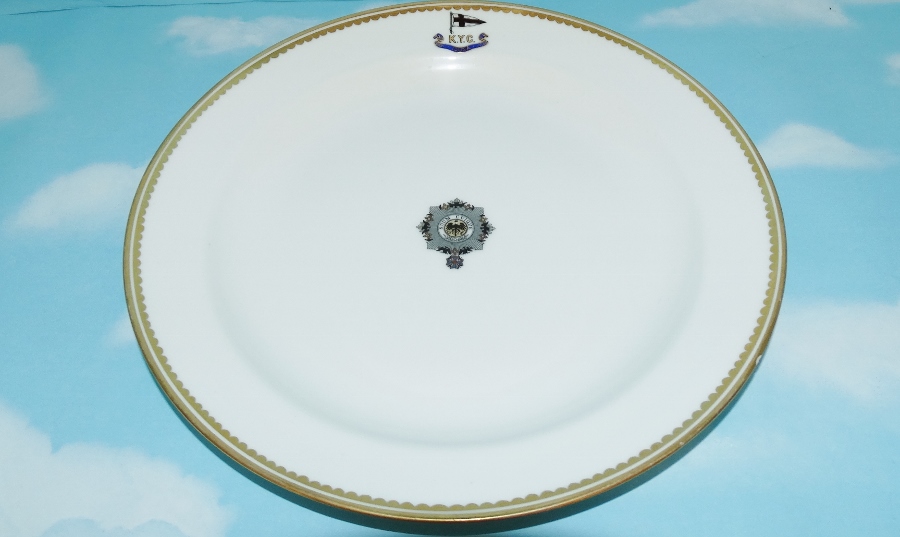
by Alore Arrington | Nov 22, 2016
Kaiser Wilhelm II was an avid sailor. He had a special place in his heart for his Navy AND his personal yachts. Today we are offering a very rare dinner plate from his racing sloop, the S. M. Y. Iduna. He raced it with the Kaiserlicher Yacht Club (KYC). The latter had its origins in a yacht club originally founded in 1887 for Kiel’s naval officers. It was known as the Marine-Regatta-Verein, and its original patron was Prinz Heinrich of Prussia, Wilhelm II’s younger brother. Heinrich was a serving officer in the Kaiserliche Marine and a yachting enthusiast. [He later rose to the rank of Großadmiral and commanded the German naval forces based in Kiel against the Russians].
In 1891, the club was opened to civilians as well as naval officers. Industrialist and arms manufacturer Alfred Krupp, along with other well-known Germans, joined the group. They asked Kaiser Wilhelm II to become the patron and renamed it the Kaiserlicher Yacht Club. [Naval officers revived the Marine-Regatta-Verein in 1928, and it continued to exist into WW II. It was disbanded by the Allies after the war, then re-founded in 1972 as the Marine-Regatta-Verein im Deutschen Marinebund e.V., and continues to this day].
Today we are offering a fantastic dinner plate that was part of the Kaiser’s personal table service when aboard the S. M. Y. Iduna. [PLEASE NOTE: Wilhelm II’s wife, Kaiserin Augusta Viktoria, had her own tableware for the S. M. Y. Iduna. We are fortunate enough to hold a singe example of it. Also, Johannes von Karpf served as commander of both the S. M. Y. Iduna and the S. M. Y. Hohenzollern. He rose to the rank of Admiral in the Kaiserliche Marine]. This magnificent plate measures 8 ½” in diameter. It has two different styles of gold trim bands around its edges. Its centerpiece is an Order of the Black Eagle Kette, whose center features the motto “Suum Cuique.” The latter also appeared on the headdresses of Gardekorps Garde units, including Infanterie, Kavallerie, Artillerie, etc. The Kaiserlicher Yacht Club’s burgee (pennant) appears at the plate’s top. Below the burgee the K. Y. C.’s initials appear in gold above a blue bandeau displaying the name “Iduna” in gold.
The plate’s reverse displays KPM of Berlin’s proper hallmarks. This notable firm, which still exists today, was the House of Hohenzollern’s official purveyor for all its royalty. We also see “1906,” the year that the plate was manufactured and entered into service aboard the S. M. Y. Iduna. Also on the reverse is a sticker showing that the plate was sold at a 2002 Christie’s auction. I felt this was a part of the plate’s history and opted to leave it for its new owner.
The plate comes from what may be the rarest tableware setting that Kaiser Wilhelm II owned. His naval tableware is much rarer than that featured at his various palaces, primarily because the ships’ smaller dining rooms accommodated far fewer guests. Since it was a racing sloop, the S. M. Y. Iduna was by far the smallest of all the Kaiser’s vessels, rendering any surviving examples of its tableware quite rare. The inclusion of the Kaiserlicher Yacht Club’s burgee makes this a very desirable piece. It is a pleasure to be able to share it with you today.
[PLEASE NOTE: a very small chip appears on the plate’s edge. I did not notice it the first time I examined the plate. I only noticed it when I dragged my fingertip over the edge and felt the roughness of a chip. To be honest, you have to look closely to even find it. It is barely noticeable. The asking price of the plate reflects its flaw. Had it been perfect like the other plates we are offering from the S. M. Y. Iduna, the price would have been several hundred dollars more].
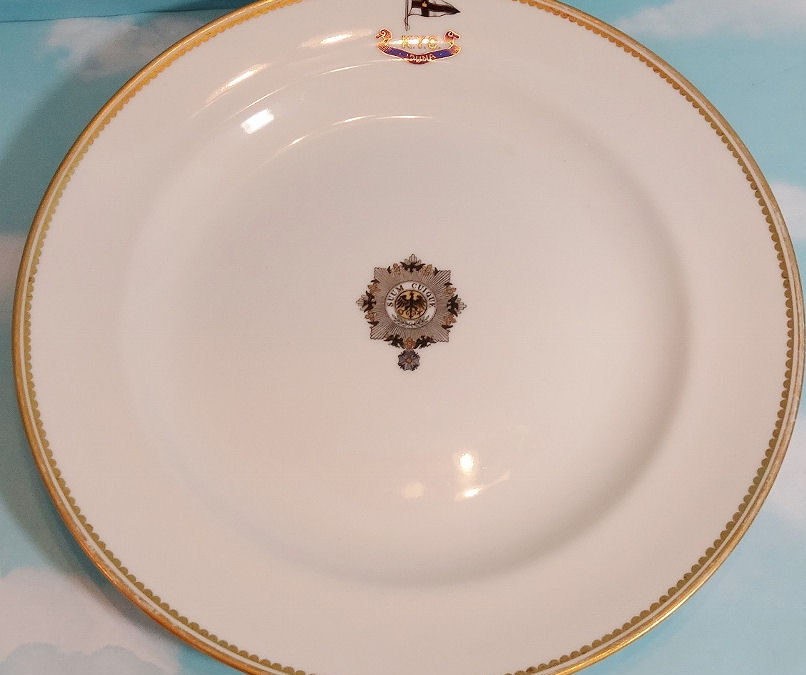
by Alore Arrington | Nov 22, 2016
Kaiser Wilhelm II was an avid sailor. He had a special place in his heart for his Navy AND his personal yachts. Today we are offering a very rare dinner plate from his racing sloop, the S. M. Y. Iduna. He raced it with the Kaiserlicher Yacht Club (KYC). The latter had its origins in a yacht club originally founded in 1887 for Kiel’s naval officers. It was known as the Marine-Regatta-Verein, and its original patron was Prinz Heinrich of Prussia, Wilhelm II’s younger brother. Heinrich was a serving officer in the Kaiserliche Marine and a yachting enthusiast. [He later rose to the rank of Großadmiral and commanded the German naval forces based in Kiel against the Russians].
In 1891, the club was opened to civilians as well as naval officers. Industrialist and arms manufacturer Alfred Krupp, along with other well-known Germans, joined the group. They asked Kaiser Wilhelm II to become the patron and renamed it the Kaiserlicher Yacht Club. [Naval officers revived the Marine-Regatta-Verein in 1928, and it continued to exist into WW II. It was disbanded by the Allies after the war, then re-founded in 1972 as the Marine-Regatta-Verein im Deutschen Marinebund e.V., and continues to this day].
Today we are offering a fantastic dinner plate that was part of the Kaiser’s personal table service when aboard the S. M. Y. Iduna. [PLEASE NOTE: Wilhelm II’s wife, Kaiserin Augusta Viktoria, had her own tableware for the S. M. Y. Iduna. We are fortunate enough to hold a singe example of it. Also, Johannes von Karpf served as commander of both the S. M. Y. Iduna and the S. M. Y. Hohenzollern. He rose to the rank of Admiral in the Kaiserliche Marine]. This magnificent plate measures 10″ in diameter. It has two different styles of gold trim bands around its edges. Its centerpiece is an Order of the Black Eagle Kette, whose center features the motto “Suum Cuique.” The latter also appeared on the headdresses of Gardekorps Garde units, including Infanterie, Kavallerie, Artillerie, etc.
The Kaiserlicher Yacht Club’s burgee (pennant) appears at the plate’s top. Below the burgee the K. Y. C.’s initials appear in gold above a blue bandeau displaying the name “Iduna” in gold. The plate’s reverse displays KPM of Berlin’s proper hallmarks. This notable firm, which still exists today, was the House of Hohenzollern’s official purveyor for all its royalty. We also see “1907,” the year that the plate was manufactured and entered into service aboard the S. M. Y. Iduna.
The plate comes from what may be the rarest tableware setting that Kaiser Wilhelm II owned. His naval tableware is much rarer than that featured at his various palaces, primarily because the ships’ smaller dining rooms accommodated far fewer guests. Since it was a racing sloop, the S. M. Y. Iduna was by far the smallest of all the Kaiser’s vessels, rendering any surviving examples of its tableware quite rare. The inclusion of the Kaiserlicher Yacht Club’s burgee makes this a very desirable piece. It is a pleasure to be able to share it with you today.

by Alore Arrington | Nov 14, 2016
This is a pair of hauptmann’s shoulder boards from Füsilier-Regiment Prinz Heinrich von Preußen (Brandenburgisches) Nr 35. This is one of the elite regiments in the German army in which Prinz Heinrich served as the Regimental Chef. These shoulder boards are of the sewn-in variety. It is clear that they have been removed from a tunic at some point. Each of the shoulder boards sports the gilt regimental number and a hauptmann’s twin, gilt pips.
by Alore Arrington | Nov 5, 2016
This is a postcard of the Kleiner Kreuzer (light cruiser) S. M. S. Hamburg. She was a part of the Bremen Kleiner Kreuzer Klasse. During the 20th Century’s first ten years she was in constant use as a escort ship for Kaiser Wilhelm II’s royal yacht, the S. M. Y. Hohenzollern. During WW I she served as a U-Boot flotilla commander’s flagship during operations around Helgoland Island and the Battle of Jutland (Skagerrak). The postcard shows the vessel sailing under a bridge, with Prinz Heinrich of Prussia aboard. It was never used
by Alore Arrington | Nov 5, 2016
The S. M. S. Beowulf was a part of the “Siegfried” class of coastal defense ships. She was commissioned in 1892 at the beginning of the Kaiserliche Marine’s “battleship era.” Interestingly, her first commander was Prinz Heinrich of Prussia, Kaiser Wilhelm II’s brother. At the time, Heinrich was a Kapitän zur See (his U.S. Navy equivalent today might command an aircraft carrier). [Prinz Heinrich later rose to the rank of Großadmiral, one of six in the Kaiserliche Marine]. The Beowulf was modernized early in the 20th Century, but in reality she did not have sufficient artillery to be a real threat. When WW I began, she was used for coastal defense. Late in the war she served as an U-Boot target ship and as an icebreaker in the Baltic. After the war, she was scrapped. The postcard shows her in profile entering a port or channel. The postcard was never mailed.

by Alore Arrington | Oct 31, 2016
This is an amazing find for us at Der Rittmeister Militaria. Today we are offering a very special, full Admiral’s überrock. Finding tunics for General Officers is a hard task, although we are proud that our current inventory boasts tunics or complete General’s uniforms for Prussia, Württemberg, Saxony, and Braunschweig. Finding tunics for Kaiserliche Marine Admiräle is indeed a daunting task. Even tunics for junior officers are NOT easy to find. [We were blessed in the past to offer none other than Großadmiral Prinz Heinrich of Prussia’s überrock].
The Kaiserliche Marine possessed only four Admiräle levels. Unlike the Imperial German Army, which featured five Generals’ levels, the Navy did not sport a Generaloberst’s equivalent (the Army’s Generaloberst being its highest rank). The Navy Admiräle ranks included the four positions listed below, in lowest-to-highest order.
Konteradmiral
Vizeadmiral
Admiral
Großadmiral
For the most part, Admiral was the Kaiserliche Marine’s highest operational/tactical rank. Of the six men who achieved the Großadmiral’s rank, only ONE actually commanded fleet operations: Prinz Heinrich, Kaiser Wilhelm II’s younger brother. He commanded activities in the Baltic during WW I, and did not achieve his rank until 1909. The rest of the six included two who commanded the overall Kaiserliche Marine (Alfred von Tirpitz [1911] and Henning von Holtzendorff [1918]), and whose official titles were “State Secretaries of the Imperial Navy Office.” Another, Hans von Koester, received the rank in 1905, primarily as a thank-you when he was approaching retirement. The final two recipients were royals (Kaiser Wilhelm II and King Oskar II of Sweden), both of whom received the rank in 1901, the year in which it was originated.
So, a man who achieved an Admiral’s rank was a very high level naval officer who commanded great responsibility within the Kaiserliche Marine. Today, we are offering just such a man’s überrock. [The classic naval überrock was a frock coat that extended down its wearer’s legs, rather than stopping near the waist as did most tunics]. Our überrock is made from fine-quality, dark-blue, buttery-smooth wool. It sports a double row of gleaming gilt buttons (five-per-side) that run down the uniform’s center. The buttons display fouled anchors with Hohenzollern Crowns above them. The überrock’s left breast features a row of sewn-in loops for displaying a ribbon bar. The loops’ total width is 2.”
The shoulder boards are of the slip-on variety. Each features a small gilt Navy button, and the two silver pips typical of an Admiral’s shoulder boards. [It is one area where the Imperial German Navy’s shoulder boards differed from those belonging to the Army. For the Army, silver pips generally indicated an à la Suite officer, whereas gold pips signaled a staff or field-assigned officer. Navy shoulder boards were the exact opposite]. These shoulder boards feature “Russian rope” bullion, whose design displays alternating silver and gold rows. The silver bullion rope is imbedded with black chevrons. The shoulder boards have the dark-blue underlay characteristic of all Navy shoulder boards (a key point when confirming Navy status).
Each überrock sleeve displays a small gold bullion Hohenzollern Crown that measures 1 ” x 1 ½.” Each sleeve also reveals a wide gold bullion tape band that measures 2,” as well as two narrow gold bullion tape bands that each measure ” in width. It is here that we discover an anomaly. Two bands indicate a Vizeadmiral, while three stand for a full Admiral. I examined the shoulder boards closely, checking their size, fit, and etc. It is clear to me that they have been attached for a long time, and are NOT recent additions. [It is my view (and that of other knowledgeable collectors and experts) that the überrock’s owner never took the tunic to a tailor to have the other bullion band added after his promotion. As it is likely that a man of his rank owned several uniforms, it is quite possible our offering was an earlier tunic that he did not upgrade. He simply inserted the correct shoulder boards once he was promoted from Vizeadmiral to Admiral. Then he later purchased other tunics with the correct sleeve markings and shoulder boards].
The überrock’s reverse exhibits six more (three per side) large gilt buttons in its vent area. Its interior displays a magnificent, superior quality black silk lining. The inside lining possesses three large pockets. Two are slash examples, while the third is the more conventional vertical example. The entire liner is in excellent condition.
The überrock is in stunning condition, overall. We are pleased to share it with you today.
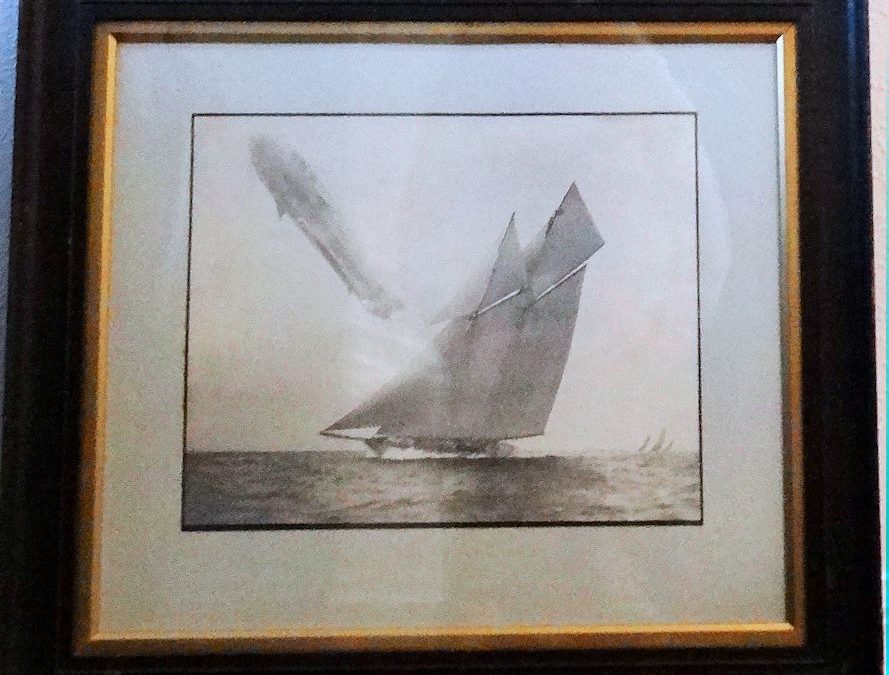
by Alore Arrington | Sep 17, 2016
Kaiser Wilhelm II was a man with a passion for the sea. His Kaiserliche Marinewas his pride and joy. He and his Chief of the Admiralty, von Tirpitz, had grand plans to expand the Navy and challenge England on the high seas. Of course, the problem here was that the British also had great pride in their Navy and were well aware that it was their key means of strengthening their overseas possessions and holding on to the shipping lanes. So, if the Germans built four battleships, the English built eight even bigger and better than what the Germans had produced, which challenged the Germans to up the ante. This was a game that Germany could never win, however. By the time the Great War began, all the battleships that had been built on both sides from 1900 to 1905 were obsolete and relegated to secondary roles as they were no longer fit for front-line duty.
In addition to his love for his Navy, the Kaiser enjoyed the sea in other roles. He spent long periods of time aboard his royal yacht the S. M. Y. Hohenzollern. From the time that the yacht was commissioned in 1892 until it was laid up when WW I began in 1914, he spent a total of more than five solid years onboard. Much of this was spent in Norway anchored in a fjord with a German warship accompanying him.
The Kaiser was also a yachtsman and served as the Kaiserlicher Yacht Club’s (KYC) Commodore. This club was similar to many of today’s yacht clubs. Men of means and naval officers enjoyed the social aspects of joining a club of fellow enthusiasts. Fine dining and fine wine were the order of the day in the club house. They did not neglect their yacht racing, however. Some of Germany’s and Europe’s finest yachts participated in races sponsored by the KYC.
This leads us to our featured item. What I really like about this photograph is that it combines two aspects of pre WW I Germany. It combines an airborne zeppelin sailing above a racing sloop on the water. As previously noted, the Kaiser was an avid yachtsman. While this included time on his yacht, he also had his personal racing sloop, theS. M. Y. Meteor. Actually FIVE Meteors were purchased by the Kaiser or were built to his specifications. The first two were built in Scotland. The first was purchased from a British yachtsman who, in addition to sailing it in England, participated in the America’s Cup yacht race. The Kaiser owned this yacht from 1891-1896. The second was built in Scotland to Wilhelm II’s specifications and was sailed from 1896-1902. The third S. M. Y. Meteor was American-built, which began a friendly pre WW I relationship between the two countries during Teddy Roosevelt’s presidency. This vessel was christened in 1902 and was sailed from 1902 to 1908. The Kaiser’s brother, Prinz Heinrich (also a seaman) traveled to New York for the christening. [I recently saw that a magnificent Damascus sword in a presentation case, presented to Prinz Heinrich during his historic New York visit, was sold at an auction]. President Roosevelt’s oldest daughter, Alice Roosevelt (1884-1980), was chosen as the yacht’s godmother. Prinz Heinrich was well-received during his visit.
The 4th and 5th Meteors were German-built, which gave the Kaiser a great deal of pride. The 5th, and final, Meteor had sailed to England in 1914 fully under wind power as she had not had auxiliary engines installed. She barely made it out of England before war was declared! [Several other German yachts were not so lucky and were confiscated by the British once war was declared].
This photograph is either Meteor #3 or #4, I believe. The ship is heeled-up with one side lower to the water in the classic manner in which to attain the greatest speed. One other yacht appears in the distance, while a pre war zeppelinmajestically sails over the racing sloop. The yacht and the zeppelin are the photo’s central focus.
The photograph is double-matted with white and black mattes. The image measures 17” x 23.” The overall dimensions of the framed photograph are 24 ¼” x 30.” The photograph’s framing is definitely period. Its outer portion sports a fancy black molding. Smaller gold trim appears closer to the image.
The story of the framing and its origin does not end here. As we look at the frame’s reverse, we see a paper backing over the image. On it we find two interesting “surprises.” The first is a postcard that shows a similar scene to the obverse. This shot, however, shows the zeppelin above a larger group of racing yachts. A total of SEVEN yachts appear beneath thezeppelin in a long line.
Under the postcard is an older label (it definitely exhibits honest age) that lists the name of George Trubey, who was located in Cardiff, Wales. He was a member of the Fine Art Trade Guild. Included among his services were fine art, picture frames, and restorations!
This is a fine photograph that shows the importance of European yachting and of the zeppelin industry, which was young and struggling at the time under the leadership of the Graf Zeppelin himself.
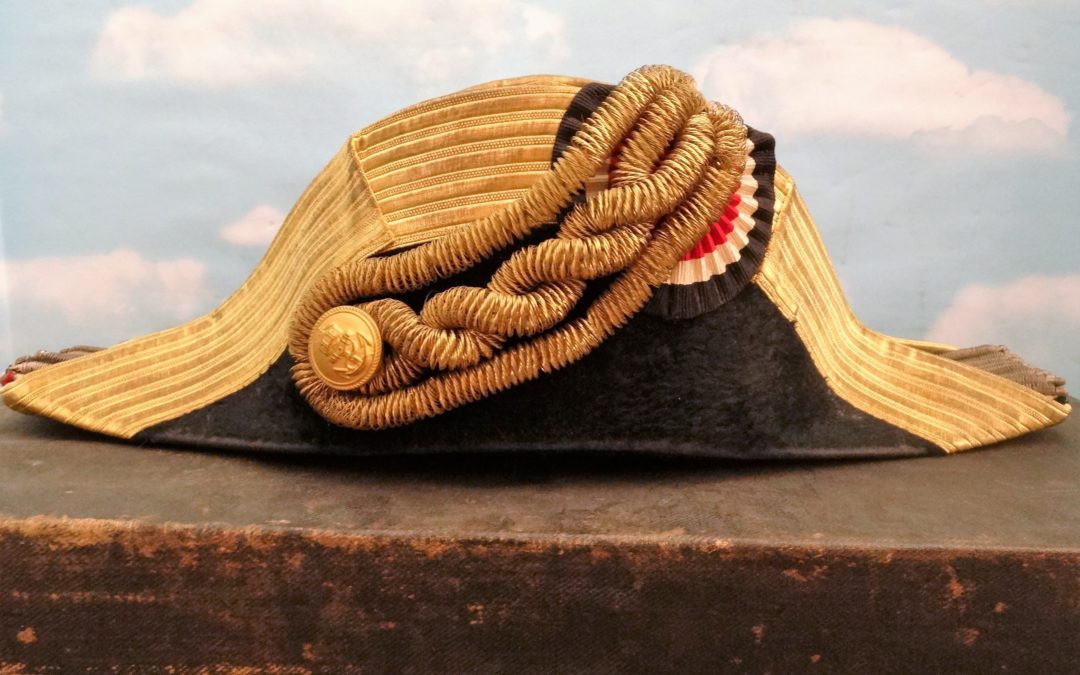
by Alore Arrington | Aug 21, 2016
I first offered this group over a decade ago. The fellow who has owned it since then recently changed his area of interest, so I was thrilled to take it back in trade. (Items like this just do NOT become available often). Hans von Koester was one of six Imperial Period men (five Germans and one Swede) appointed as a Großadmiral. The rank was created in 1901, with Kaiser Wilhelm II (naturally) appointing himself the first rank holder. King Oskar II of Sweden was granted the same rank that year as a ceremonial gesture. Listed below are the six men who held the rank from 1901 until the empire’s end in 1918.
1901 – Kaiser Wilhelm II (1859–1941)
1901 – King Oskar II of Sweden (1829–1907)
28 June 1905 – Hans von Koester (1844–1928)
4 September 1909 – HRH Prinz Heinrich of Prussia (1862–1929)
27 January 1911 – Alfred von Tirpitz (1849–1930)*
[*Promoted on an Honorary Basis without Patent]
31 May 1918 – Henning von Holtzendorff (1853–1919)
The first two recipients were ceremonial appointments rather than direct commands. The third appointee, Hans von Koester, was the first “operational” admiral to receive the rank. He was promoted to Großadmiral in 1905 as a reward for his long service. He actually retired the following year (1906). The next to receive the rank was Prinz Heinrich, (one of whose tunics and officer’s summer schirmütze we are proud to offer). Heinrich held direct command in the Kaiserliche Marine and was a royal, so his appointment was not an à la Suite promotion. Heinrich was the second officer with a naval background to achieve the rank. Alfred von Tirpitz was the third.
*[PLEASE NOTE: von Tirpitz’s promotion must be viewed with an “asterisk.” His promotion was WITHOUT patent. That is, he was a Großadmiral in title, but his rank was more like that of an à la Suite (an honorary appointment for royalty ONLY). This somewhat confusing situation was evident on two different von Tirpitz shoulder boards we have offered in the past. Instead of a Großadmiral’s crossed batons, those boards displayed FOUR pips, which indicated the equivalent of a Generaloberst in the rank of Generalfeldmarschall. The latter was a rank often used by royals in the Imperial German Army, and officially WAS an à la Suite position. Prior to the institution of Großadmiral, the Imperial German Navy’s highest rank was a full Admiral, who wore TWO pips. The Navy had no equivalent to the Imperial German Army’s Generaloberst, who displayed THREE pips. The Navy simply skipped the rank! The number of shoulder board pips displayed on the four admirals’ ranks was as follows: a Konteradmiral wore NO pips; a Vizeadmiral displayed ONE pip; an Admiral boasted TWO pips; and a Großadmiral had NO pips, but instead displayed crossed batons].
The final man to achieve the rank was Henning von Holtzendorff. He assumed Alfred von Tirpitz’s role, and also did not exercise direct command after his promotion. In fact, he retired before the war’s end due to health problems (he died in 1919). Von Holtzendorff was replaced by Admiral Reinhard Scheer (the High Seas Fleet commander at 1916’s Battle of Jutland/Skagerrak). Scheer was responsible for running the Navy, but was NOT awarded a Großadmiral’s rank. The following small group of Großadmiral Hans von Koester’s personal effects is absolutely marvelous.
PAIR OF GROßADMIRAL’S EPAULETTES. I have seen some superb shoulder boards and epaulettes over the years, including those from the Kaiser. Nothing, however, has ever touched the sublime beauty of these truly magnificent specimens. Their centers are made of gold silk! Wool or felt is normally used for background material, not silk. Each center is highlighted by a pair of crossed batons. The batons’ artistry sets them apart from any Army Generalfeldmarschall’s batons. Army batons usually are made of silver, rather than the exquisite enamel used by the Navy. These display four different colors: gold, white, red, and black. Neither epaulette displays any damage whatsoever to these magnificent batons. A massive silver eagle grasping a fouled anchor in its claws overlays each baton set. Just below a small gilt naval button on the epaulette’s tongue is a silver Kaiser Crown. The tongue also displays red and black piping on a white background. The use of red, black, and white (the national colors) indicates that the Kaiserliche Marine was under the Reich’s authority, not the Kingdom of Prussia’s.
More gold design work extends out from the silk field on which the batons and eagles are mounted. Massive gold ringlets flow down majestically around their edges. (They must have looked amazing when worn on the dress uniform)! The epaulettes’ undersides are covered in navy-blue wool, another sure sign that they are correct for the Kaiserliche Marine. A sliding brass clip arrangement allows them to be slipped onto the tunic.
Looking at these epaulettes and their superb condition, one would be hard pressed to believe they are more than one-hundred-years-old.
GROßADMIRAL’S UNIFORM CUFFS. Imperial German Navy Admiräle uniforms displayed gold bullion stripes that indicated the man’s rank. Daily-use tunics did NOT display shoulder boards, so rank was determined by the number of stripes on the cuffs. In a Großadmiral’s case, FOUR stripes designated his rank. Each of these stripes measures 9/16″ in width. In addition to the rank stripes, a single wide band of gold bullion is present that measures 1 15/16″ in width. Its bullion displays a wonderful patina, with gentle toning. Each cuff normally had a bullion Kaiser Crown attached, as well. Only one of them is present, and is NOT attached to the cuff. [We will show this in our photographs]. Each cuff is wrapped very neatly in some very old tissue paper. Both are most attractive.
FORE & AFT CAP (ZWEISPITZ) BELONGING TO ADMIRAL HANS von KOESTER. Naval officers wore two types of headdresses. First, for regular duty, was the schirmütze (visor cap). Second, for more formal occasions, and often worn with a Gala Naval Uniform, was the zweispitz (fore and aft cap). [Naval officers actually had three types of uniforms: daily wear, dress, and high-dress (Gala). Many officers did not even have a Gala uniform unless they were of higher rank or were extremely wealthy]. In the USA, we more frequently associate fore and aft caps with naval headdresses from the 18th and early 19th Centuries. In the Kaiserliche Marine, an Admiral’s zweispitz was different from the other officers’ headdresses. Von Koester’s zweispitz is significantly and magnificently more elaborate.
The zweispitz’s body is covered with close-cropped very fine fur, perhaps seal. In addition to the golden coil that extends from the gilt navy button on the cap’s right side, the other huge difference is a 2 ½”bullion band that runs the length of the cap’s two sides. Each of the cap’s ends sports multiple silver bullion ringlets. Beneath the top row of silver ringlets is another row that is interspersed with silver, red, and black ringlets. The cap’s right side boasts a large and very elegant silk Reich’s kokarde.
Turning to the interior, we see a very high-quality, light-brown leather sweatband. It is 100% complete and in excellent condition. If we look closely, in a place or two we can see some very slight sweat stains from where von Koester actually wore it! The white silk liner is flawless and in superb condition. His name, “von Koester,” is embossed in gold on the white silk liner.
STORAGE CASE FOR ALL ITEMS LISTED ABOVE. This is a large storage case that measures 8 1/4″ x 9″ x 18.” The case was used to store the epaulettes and zweispitz when not in use. It has a handle on the top that made it convenient for use when traveling. On the case’s front is a small plaque that measures 1 3/16″ x 3 ½” and bears his name: “von Koester.” When I originally bought the group many years ago, the case’s top half was separated from its bottom half. The hinges and screws that secured them had pulled loose. When I bought the group back, I decided to address the problem. Normally, I prefer to avoid restoration, but in this case I felt it was in order. So we inserted new screws in the original hinges and the case operates as it did more than one-hundred-years ago. The original key is attached to the handle!
Inside the case we see that the zweispitz is nestled at the bottom. Over it is a red silk platform. The platform performs two purposes. It separates the zweispitz from the contents at the case’s top. That is where the platform becomes the epaulettes’ storage stand. Each epaulette slides onto the platform and is secured. The tunic cuffs are folded in their tissue and laid at the top, which makes for a tidy package.
SILVER PRESENTATION PLATE FROM von KOESTER’S STAFF WHEN COMMANDER OF DER MARINE STATION den OSTSEE. This is an ultra-high-quality silver presentation plate. It measures 11″ in diameter. The plate’s edges display very elaborate scrollwork accented with a floral motif. The following dedication is engraved at the plate’s top: “Unserem Hochverehrten Stationschef Admiral H. Koester” (Our esteemed station-chief Admiral H. Koester). Another engraving is presented at the plate’s bottom: “Die Offiziere der Marinestation der Ostsee” (The officers of the Baltic Sea Marine Station). An admiral’s flag is in the plate’s center. Below that is the presentation’s date, 22 März 1897. The plate’s reverse is highly tarnished and bears the manufacturer’s hallmark, as well as one for .800 silver, and the initials “AP.”
The Marinestation Ostsee was the Baltic Sea Naval Station located in Kiel. Von Koester held this post from 1889 to 1903. It should also be noted that he is recognized as an Admiral, rather than the lower rank of Vizeadmiral. It is interesting to note that von Koester received the promotion in 1897, the same year as the plate! The plate is in amazing condition for its age.
COLOR POSTCARD AND DETAILED HISTORICAL INFORMATION OF HANS von KOESTER. We are including a period color postcard of Großadmiral Hans von Koester. We thought it important that you know what the man looked like. We also have some historical background on him that chronicles his long career.
Words cannot adequately describe the beauty, rarity, and historical importance of this group. If you are a collector of Kaiserliche Marine items, we have many other important items including Prinz Heinrich’s aforementioned group, an overcoat with shoulder boards for a Großadmiral, and numerous epaulettes for every officer rank up-to-and-including a Kapitän zur See. (Please browse our “NAVY” Merchandise Page to see them, click here to see).

by Alore Arrington | Aug 21, 2016
This is a privately-purchased, non depot-issued enlisted man’s mütze from a Hesse-Darmstadt Artillerie-Regiment. After the four Imperial German Kingdoms’ Armies (Prussia, Saxony, Bavaria, and Württemberg), the Grand Duchy of Hesse-Darmstadt had one of Germany’s largest military contingents. Among the many regiments they fielded were two artillerie regiments: Großherzogl. Artilleriekorps. 1. Großherzogl. Hessisches Feldartillerie-Regiment Nr 25, and 2. Großherzogl. Hessisches Feldartillerie-Regiment Nr 61. [Interestingly, Großherzogl. Artilleriekorps. 1. Großherzogl. Hessisches Feldartillerie-Regiment Nr 25 was one of the oldest German Army Artillerie-Regiments. Only one Prussian, one Saxon, and two Württemberg regiments were older]. Also, the regiment’s Inhaber was Prinz Heinrich von Preußen, Kaiser Wilhelm II’s younger brother.
Our mütze is of the highest quality. It comes from the workshops of P. H. Lorz, located in the capital city of Darmstadt. They were the official providers to Hesse-Darmstadt’s Royal House and the Grand Duke. Both of the aforementioned regiments were garrisoned in Darmstadt, so a man from either regiment could have owned this mütze. The mütze’s basic body color is dark-blue. It sports a wide black trim band, measuring 1 ⅛,” accented above and below by thin bands of red piping. Another band of red piping encircles the mütze’s top. The German Reich’s kokarde and Hesse-Darmstadt’s state kokarde both are firmly in place. The mütze’s exterior condition is very near mint. Inside the mütze is a very lightly-used leather sweatband. The leather is fresh and supple, with no sweat staining. A red silk liner is present. The maker’s name, P. H. Lorz, and address are embossed on it. A paper tag is in place advising that the mütze is a size 54 ½. The mütze is stored in a circular carton, which is why it has remained in such spectacular condition. Again, the manufacturer’s name appears on a label on the carton’s front.
This is an amazing mütze, in stone-mint condition. The example cannot be upgraded. You will be very pleased with its condition.
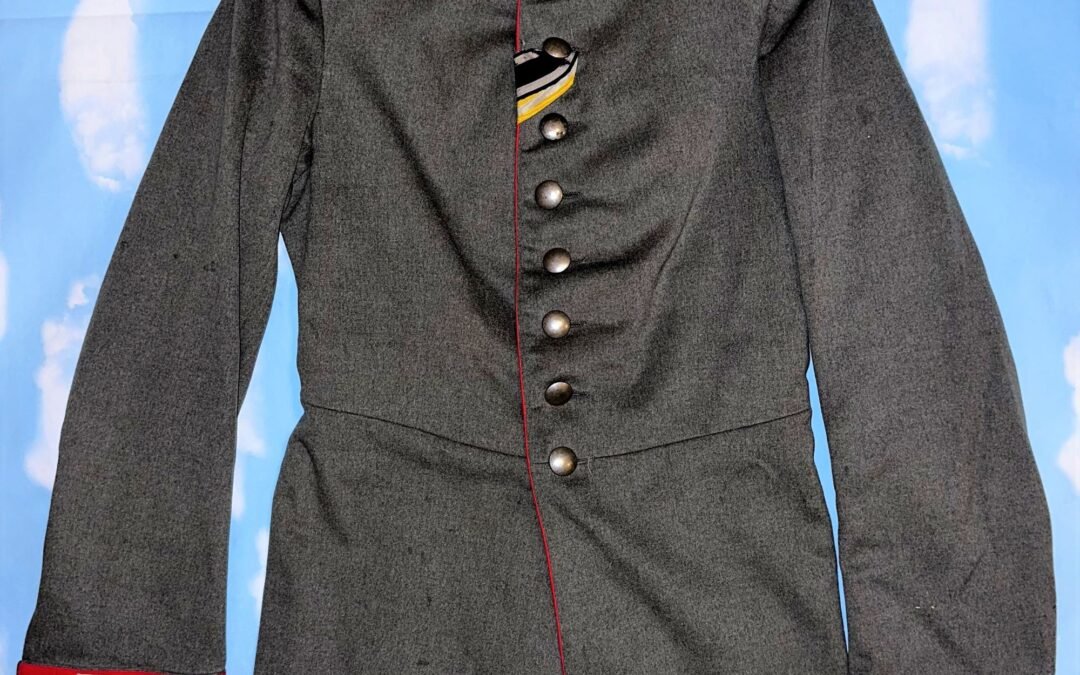
by brandefined | May 31, 2023
This meticulously preserved M-1910 feldgrau tunic represents the esteemed Infanterie-Regiment Nr 100 from the Kingdom of Saxony. Serving as “The King’s Own,” this regiment held the distinction of being the leading infantry unit in the Kingdom, with its officers comprising nobles and members of the royal family of Saxony. Even those enlisted who were not of nobility or royalty hailed from esteemed backgrounds within Saxony. Being selected to be a part of this regiment, regardless of rank, was a true honor….





























